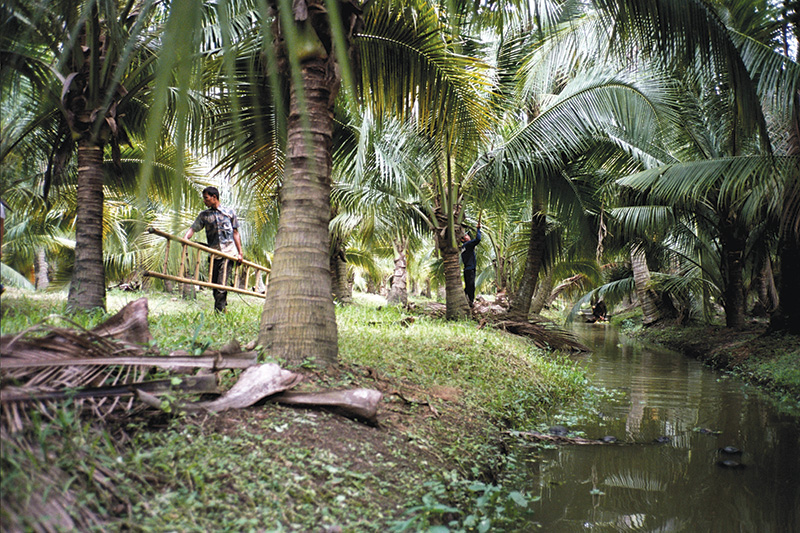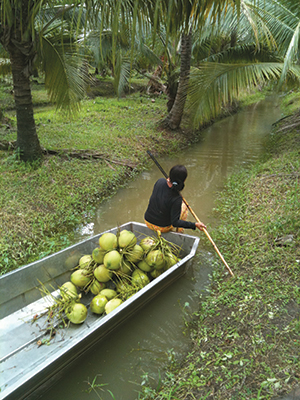Coconut Water Goes Green
As the coconut water market explodes, the world’s trendiest drink tries to get more natural.
Just 10 years ago, one of the few ways to drink coconut water was to fly to a beach somewhere and crack a green nut fresh from the tree. The straw, of course, was optional.
Today, coconut water is nearly a billion-dollar industry. Global demand for coconut water grew by 168 percent from 2010 to 2013 and the number of new products has skyrocketed, increasing 540 percent between 2008 and 2012.
Vita Coco, the leading brand, could be credited (or blamed) for creating this swift mainstream demand. With Madonna as an investor and Rihanna on billboards, their global sales jumped to $323.2 million last year. They are even creating kids’ coconut drinks with 20th Century Fox and Blue Sky Studios, inspired by the film “Rio 2.”

Coca-Cola and PepsiCo., meanwhile, have rushed to buy two other major players, ZICO and O.N.E., respectively.
The race is on: Coconut water companies are now falling over themselves to up the coconut water ante. Boasting of unique selling points – “organic,” “raw” and “pure” are three favorites – these mainstream beverage companies are also adding exotic flavors like green tea, espresso and even Thai chili extract. And with those flavors come lots of sugar, food coloring and chemical additives.
How did coconut water get so far from its roots? One, because coconut water is highly perishable when taken out of its protective nut, most commercial bottlers resort to flash pasteurization, which can destroy some of the nutrients and taste of natural coconut water. Other bottlers make coconut water from concentrate.
[mf_list_sidebar_item img=”https://modernfarmer.com/wp-content/uploads/2014/06/nut1.jpg” itemtitle=”A Coconut:”]
What’s the packaging made of? Coconut.
How sustainable is it? Very. It’s its own container and refrigerator, and it’s 100 percent biodegradable![/mf_list_sidebar_item]
[mf_list_sidebar_item img=”https://modernfarmer.com/wp-content/uploads/2014/06/nut2.jpg” itemtitle=”Vita Coco:”]
What’s the packaging made of? Recycled wood fibers mixed with small amounts of polyethylene and aluminum.
How sustainable is it? Quite. Using recycled and sustainably harvested wood fibers, these cartons are almost as good as it gets.[/mf_list_sidebar_item]
[mf_list_sidebar_item img=”https://modernfarmer.com/wp-content/uploads/2014/06/water.jpg” itemtitle=”Jax Coco:”]
What’s the packaging made of? Recyclable glass.
How sustainable is it? Not very. Reusable, glass production and transportation-related emissions really add up, but it’s still better than plastic.[/mf_list_sidebar_item]
[mf_list_sidebar_item img=”https://modernfarmer.com/wp-content/uploads/2014/06/nut4.jpg” itemtitle=”Harmless Harvest:”]
What’s the packaging made of? Single-use polyethylene terephthalate plastic (PET1).
How sustainable is it? Not very, at the moment. Harmless Harvest must use plastic due to its high-pressure processing, but it’s pledged to switch to rPET (post-consumer recycled) plastic very soon.[/mf_list_sidebar_item]

Almost overnight, this one-time ultranatural health drink has become just another adulterated beverage, a fact that has not gone unnoticed by consumers. It’s why a whole new crop of enterprising companies have sprung up to return some sustainability to this inherently natural drink.
One of the new wave of coconut water producers, San Francisco”“based Harmless Harvest, says its coconut water is “100 percent raw.” The company has replaced heat pasteurization with a high-pressure processing (HPP) system – treating the water with thousands of pounds of pressure to prevent bacteria growth without stripping it of nutrients.
“I’m not a raw foodist,” says co-founder Justin Guilbert. “But I do adhere to basic common sense. A freshly squeezed orange juice usually tastes better than a not freshly squeezed orange juice.”
The company also spent years building relationships with farmers in Thailand who still grow coconuts through traditional methods, without chemicals or fertilizers, and harvest them carefully. They pick coconuts by hand, lower them by rope and then transport them by boat via canals to prevent damage. To provide farmers with much-needed stability in a volatile marketplace, Harmless Harvest pays a higher price for organic coconuts, which has raised the overall price for coconuts across Thailand.
Another company, Bali-based Big Tree Farms, has devised a solution to the carbon-footprint problem, though it ironically necessitates another change in how the coconut water is found in nature: It sells the water in a dehydrated form. Co-owner Frederick Schilling says because coconut water is comprised almost entirely of ordinary water – about 95 to 97 percent, in fact – it made sense to take water out of the equation and offer consumers the nutrients in powder form. “It’s just a lot of water being shipped around the world for 3 percent nutrients,” he says.
Then there’s the way this natural product has been bottled, treated and flavored before ending up on supermarket shelves around the world.
Jax Coco, another new entrant to the market, has cut back on waste by becoming one of the first coconut water companies to introduce a recyclable glass bottle (bearing a sleek design by Alasdhair Willis, Stella McCartney’s husband).
The Hong Kong”“based brand has also made replanting a core part of its mission in the Philippines, where aging palm trees are hugely problematic. Many trees were planted between 50 and 60 years ago and simply can’t keep up with global coconut demand, says Jane Gottschalk, co-founder of the company.
The smaller brands are making progress, which isn’t lost on farmers at the end of the supply chain.
Samak Sapma, a coconut farmer who supplies nuts to Harmless Harvest, says as long as the farming itself is done in a sustainable manner, he doesn’t see a problem with the growing fad for coconut water.
“If coconut trees could grow in the U.S., it might not be necessary to send the coconut water from Thailand,” he says. “But I don’t think [they] could grow coconut trees as sweet and aromatic as the Thai coconut. People know the difference!”
Where Does Your Coconut Grow?
Originally the big three U.S. companies got most of their coconuts from Brazil, but demand quickly outstripped supply. This led them to shift sourcing to Asia, where nearly 90 percent of the world’s coconuts are grown.
As of 2012, Indonesia is now the top global producer, growing an estimated 19.8 million tons of coconuts, followed by the Philippines with 17.5 million and India with 11.6 million, according to the United Nations Food and Agriculture Organization (FAO).
Follow us

This work is licensed under a Creative Commons Attribution-NoDerivatives 4.0 International License.
Want to republish a Modern Farmer story?
We are happy for Modern Farmer stories to be shared, and encourage you to republish our articles for your audience. When doing so, we ask that you follow these guidelines:
Please credit us and our writers
For the author byline, please use “Author Name, Modern Farmer.” At the top of our stories, if on the web, please include this text and link: “This story was originally published by Modern Farmer.”
Please make sure to include a link back to either our home page or the article URL.
At the bottom of the story, please include the following text:
“Modern Farmer is a nonprofit initiative dedicated to raising awareness and catalyzing action at the intersection of food, agriculture, and society. Read more at <link>Modern Farmer</link>.”
Use our widget
We’d like to be able to track our stories, so we ask that if you republish our content, you do so using our widget (located on the left hand side of the article). The HTML code has a built-in tracker that tells us the data and domain where the story was published, as well as view counts.
Check the image requirements
It’s your responsibility to confirm you're licensed to republish images in our articles. Some images, such as those from commercial providers, don't allow their images to be republished without permission or payment. Copyright terms are generally listed in the image caption and attribution. You are welcome to omit our images or substitute with your own. Charts and interactive graphics follow the same rules.
Don’t change too much. Or, ask us first.
Articles must be republished in their entirety. It’s okay to change references to time (“today” to “yesterday”) or location (“Iowa City, IA” to “here”). But please keep everything else the same.
If you feel strongly that a more material edit needs to be made, get in touch with us at [email protected]. We’re happy to discuss it with the original author, but we must have prior approval for changes before publication.
Special cases
Extracts. You may run the first few lines or paragraphs of the article and then say: “Read the full article at Modern Farmer” with a link back to the original article.
Quotes. You may quote authors provided you include a link back to the article URL.
Translations. These require writer approval. To inquire about translation of a Modern Farmer article, contact us at [email protected]
Signed consent / copyright release forms. These are not required, provided you are following these guidelines.
Print. Articles can be republished in print under these same rules, with the exception that you do not need to include the links.
Tag us
When sharing the story on social media, please tag us using the following: - Twitter (@ModFarm) - Facebook (@ModernFarmerMedia) - Instagram (@modfarm)
Use our content respectfully
Modern Farmer is a nonprofit and as such we share our content for free and in good faith in order to reach new audiences. Respectfully,
No selling ads against our stories. It’s okay to put our stories on pages with ads.
Don’t republish our material wholesale, or automatically; you need to select stories to be republished individually.
You have no rights to sell, license, syndicate, or otherwise represent yourself as the authorized owner of our material to any third parties. This means that you cannot actively publish or submit our work for syndication to third party platforms or apps like Apple News or Google News. We understand that publishers cannot fully control when certain third parties automatically summarize or crawl content from publishers’ own sites.
Keep in touch
We want to hear from you if you love Modern Farmer content, have a collaboration idea, or anything else to share. As a nonprofit outlet, we work in service of our community and are always open to comments, feedback, and ideas. Contact us at [email protected].by Justin Bergman, Modern Farmer
June 19, 2014
Modern Farmer Weekly
Solutions Hub
Innovations, ideas and inspiration. Actionable solutions for a resilient food system.
ExploreExplore other topics
Share With Us
We want to hear from Modern Farmer readers who have thoughtful commentary, actionable solutions, or helpful ideas to share.
SubmitNecessary cookies are absolutely essential for the website to function properly. This category only includes cookies that ensures basic functionalities and security features of the website. These cookies do not store any personal information.
Any cookies that may not be particularly necessary for the website to function and are used specifically to collect user personal data via analytics, ads, other embedded contents are termed as non-necessary cookies.
